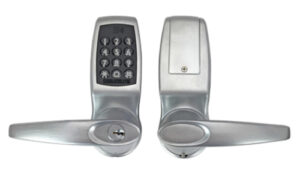 The CL4510 is a standalone door lock that is promoted as combining smart technology with a traditional keypad and card access options suitable for a range of applications.
The CL4510 is a standalone door lock that is promoted as combining smart technology with a traditional keypad and card access options suitable for a range of applications.
One of the main benefits of the system is that the user can choose the most suitable entry method for the application, therefore not limiting the scope of where installers can choose to specify the lock. Access can be via a code, MIFARE compatible card or smartphone. The lock can also be opened remotely from reception or via a building alarm. And there is also a key.
Like many systems on the market today the lock utilises an app for monitoring, management and also access, so our review will cover the basics of both the hardware and the software.
Installation
The installation procedure for the unit is fairly straightforward for anyone that has ever fitted a lock to a door. The unit is supplied along with a number of parts one of which is a template for drilling the holes into the door. Handily the template also informs of the drill bit size required for each hole.
The unit is supplied with handles/levers for left or right sided opening so no extra specification is required when purchasing systems – ie handles fit the front and back of the unit whichever way the door hangs.
Once the latch is fitted into the side of the door then the lock front, back and spindle can be attached to the door using two screws which can be cut down to match the required length for the width of the door. One is via the battery pack space in the back plate where the cabling from the front plate is fed through and attached to the batteries. The strike plate should then be attached to the door frame as instructed to prevent shimming.
In this state the lock can be used as it is by using a series of codes/button presses listed in the instructions but for more in depth access control and audit trailing etc the Bluetooth app is recommended.
Without the app
As stated, once the lock is fitted and the batteries (supplied) are fitted, the unit is ready for work. There are many functions that the lock can perform without the app, so should the unit be installed in circumstances where smartphones will not be common then the CL4510 will provide high level security on its own with codes, cards and keys.
Each of these functions is accessed by entering the Master Code which, as is the norm, should be changed at installation to prevent unauthorised access. Once the Master Code has been entered then access codes, of which there are a number of options, can be granted or suspended.
The key can also be used to open the door however the key can only be removed from the unit once the door is locked unless the ‘Classroom Function’ tailpiece is used. This would be for areas of high footfall where the lock can be overridden and the handle simply opens and closes the door.
The full review will appear in the December edition of PSI magazine

